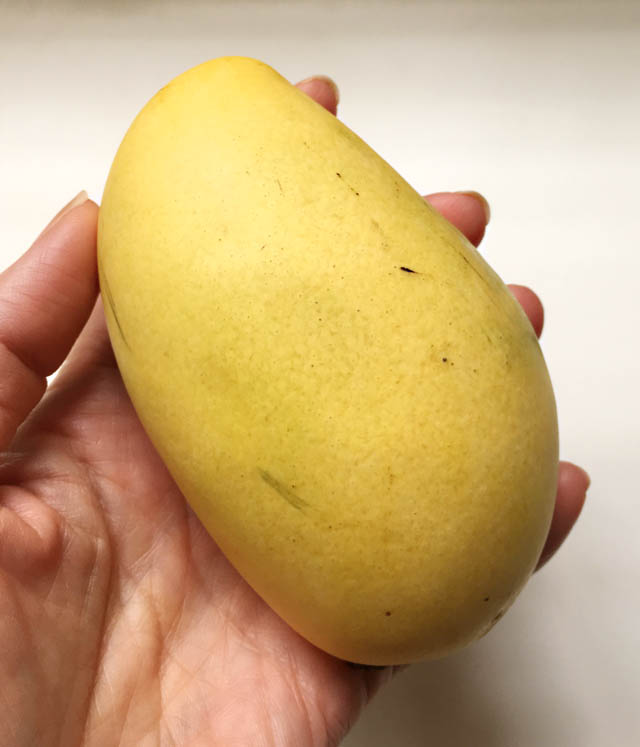Never buy pre-cut mangoes at the grocery store again! With step-by-step photos and detailed instructions, learn how to peel and cut a mango a couple of different ways so you can enjoy this deliciously tropical fruit!

Mangoes are one of the tastiest fruits out there. Tropical, sweet, delicious.
But getting to that sweet deliciousness can be intimidating and a bit of a challenging task.
Luckily for you, I'm here to show you a couple of ways to cut a mango simply and easily so you can enjoy this fruit whenever it's in season!
There are, obviously, different ways to peel and cut a mango. However, after trying various ways of cutting mangoes through the years, I’m here to show you the methods that work the best for me, every time.
The first time I tried cutting into a mango, I had no idea there was a giant pit inside. But I figured it out pretty quickly when I tried cutting the mango right down the middle and my knife hit it!
And even then, I had no idea how big the pit was. So I moved my knife over a little and tried cutting again…only to hit the pit...again...and again!
Let’s just say that that mango became quite a mangled mess by the time I was done with it!

First of all, there are different varieties of mangoes, and while their flavors might all vary, their anatomy, so to speak, are essentially the same.
Big Fat Mangoes
I know "big fat mangoes" isn't particularly scientific, but it's the best way I can describe them!
Depending on where you are in the world, they can have a variety of different names, but they are all very similar. The big fat mangoes have skins with hues of green, red, and yellow. I'd say that maybe 20 years ago, many of these varieties of mangoes were more fibrous, making them a bit harder to cut. Nowadays, however, it is more commonplace to find ones that are more meaty, not very fibrous, and hold up well to cutting.
These big mangoes are quite the handful and can get quite unwieldy when trying to peel and cut them. So I start off by cutting off a bit of the base where the stem was connected.

Now you’ve got a flat bottom to the mango and can stand it up on your cutting board!
Starting at the top of your mango, use your knife to peel the skin. Keep going until all the skin has been removed.

With the mango still sitting on its flat base that you cut earlier, you're ready for cutting!

Imagine that the pit is about ½” thick in the middle of the mango. Slice down one of the flat sides of the mango, next to where that pit is. You may feel it with your blade as you slice through.

Rotate the mango and repeat with the other side.

Next, lay your mango down and using a paring knife, cut away the meat around the edge of the pit.

Continue to carefully cut off any mango meat from the pit. Set the pit aside...but don't throw it away yet!

Cut the big flat sides and the large chunks you got off the mango into bite-sized pieces, slices, etc.

Your mango is ready to eat or throw into a blender for a smoothie! YUM!
But wait...what about the pit?? Well, now you can see how big it is! It's no wonder I couldn't cut through the middle of the mango!
You could just go and dump that pit, but seriously, there is still a decent amount of mango on it that will end up going to waste.
This is when you get messy and just suck on the pit and scrape the meat off with your teeth! It’s not pretty, you'll have juice all over your hands and on your face, and you’ll probably get “wedgies” in your teeth, but it’s totally worth getting every yummy bit you can! I'll spare you any photos of me actually doing this, but look at how much you can get off the pit!

Small Yellow Mangoes
Again, "small yellow mangoes" is not a very scientific classification, but essentially, these mangoes are smaller than the "big fat" mangoes and they are easily identified by their bright yellow skin.
Here in Hong Kong, we often get the Philippine mangoes, also known as Manila mangoes, or you might know them as Mexican Ataulfo, honey, or jade mangoes. They are less dense than the big ones, and are often sweeter and stronger in flavor.

For these ones, I cut off the bottom as usual so that I can stand the mango up on the cutting board. Then I leave the skin ON.
Slice down each side of the pit, just like with the big fat mango.

Hold one of the chunks in your hand and use a tablespoon to slide down between the skin and the meat. It's that simple!

You can also just scoop and eat, straight from the mango skin! Instant gratification!

For the meat still on the pit, use a paring knife to trim off the skin, and then cut away any meat.

Same advice goes for the pit…don’t let that precious mango meat go to waste!
So there you go! Two ways to cut and eat mangoes!
Also, keep in mind that for the big fat mangoes, you can also keep the skin on when cutting through them and scoop out the mango meat to eat right away, just like the smaller yellow ones!

They are, however, bigger than the yellow ones and end up being more than one can eat in one sitting. That’s why I like to cut them in cubes.

Mangoes are such a treat and often a sure tail sign of summer and warmer weather. We love to eat them as is, but I also love cutting up a mango and mixing the chunks in with fresh berries from an awesome fruit salad. Toss these into a blender and treat yourself a refreshing mango Fresh Fruit Sparkler!

The next time mangoes are a plenty in your neck of the woods, whether cut into cubes or scooping straight from the shell, now you know how you can get straight into enjoying them!
~ Lisa.

How To Peel and Cut A Mango
Ingredients
- Ripe mangoes
Instructions
Peel and Cut:
- Cut off the bottom of the mango where the stem is to create a flat base. Stand the mango up on this base on a cutting board.
- Starting at the top of the mango, use a sharp knife to peel away the skin, cutting in a downward direction to the cutting board. Repeat all around the mango, rotating the mango as necessary.
- Imagining the pit in the center is approximately ½" thick, slice down each flat side of the mango. Cut each mango section into chunks, slices, etc.
- Lay the mango pit down on the cutting board and carefully cut away the remaining mango meat away from the pit.
Cut and Scoop:
- Without peeling the mango, cut down each flat side of the mango, avoiding the pit in the middle.
- For each flat side, scoop out the mango flesh away from the skin with a tablespoon and cut into chunks or eat straight from the mango skin.
- Lay the pit down flat on the cutting board and carefully cut away the skin.
- Carefully cut away the mango flesh from the pit or simple eat straight off the pit!
Notes
- The Peel and Cut method also works with the smaller yellow mangoes, but they can be more fiddly to handle because of their size. I find the Cut and Scoop method works better with the small mangoes.
- Ripe mangoes have a slight give when squeezed and are mildly fragrant.
- Cut mango is best eaten fresh, but I will often keep extra in a sealed container in the fridge for a day and enjoy it the next day with yogurt or in a smoothie.
**Post updated October 5th, 2019 with the addition of a recipe card and updated text.






Pam
You're not kidding about that being messy! I slurp my seeds over the sink!
Tessa Lembke
Excellent, thanks!
dennis
thank you !! So helpful!! loved cutting off the bottom to allowed it to stand up right! made easy to peel!!
Thanks, Dennis! I'm glad the instructions were helpful!
Thomas
Now I know how to cut and peel a mango. The first one ended up a huge mess. Thank you!
Hi Thomas! So glad you found my post and that it helped! I think we all mess up the first time we ever cut into a mango!
Caroline Hviid
Juicy, luscious mangoes are sweet and delicious and packed with fiber and vitamin C. They’re also surprisingly versatile. Eat mangoes sliced over salads, cubed into mango salsas, blended into smoothies, sauteed with meat or seafood, or cut into chunks for kabobs. In this video, you’ll learn how to cut and peel a mango—you’ll see two great techniques for removing the peel and seed, and discover the best way to cut them into cubes without removing the skin. You’ll also get tips for buying mangoes and learn how to ripen under-ripe mangoes. Soon, you'll be ready to try out your new skills on recipes that include juicy, sweet mangos .